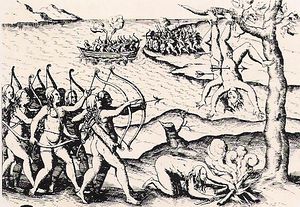أمازونيات


الأمازونيات (باليونانية: Ἀμαζόνες, Amazónes، المفرد Ἀμαζών, Amazōn) هم شعب من المقاتلات النساء, وهن أول من سخر الحصان لأغراض القتال كما تروي الأسطورة. تبرز الأمازونيات في عدة ثقافات كالميثولوجيا الأغريقية.
الأمازونيات ارتبطن بمناطق متعددة كآسيا وشمال أفريقيا الذي كان يعرف عند اليونانيين بليبيا. والرسومات في الصحراء تحكي عن نساء مقاتلات أي أمازونيات وهي عبارة عن رسومات تبرز نساء محاربات. وحسب الأسطورة مقطوعة الثدي, بحيث تقوم الأمازونيات بقطع الثدي حتى يتمكن من اسخدام القوس والنبال دون أعاقة.
الأصول


الأسطورة
في التأريخ
أدب القرون الوسطى والنهضة

Amazons continued to be discussed by authors of the European Renaissance, and with the Age of Exploration, they were located in ever more remote areas. In 1542, Francisco de Orellana reached the نهر الأمازون (Amazonas in Spanish), naming it after a tribe of warlike women he claimed to have encountered and fought on the Nhamundá River, a tributary of the Amazon.[1] Afterwards the whole basin and region of the Amazon (Amazônia in Portuguese, Amazonía in Spanish) were named after the river. Amazons also figure in the accounts of both Christopher Columbus and Walter Raleigh.[2] Famous medieval traveller John Mandeville mentions them in his book:
الخلفية التاريخية
Classicist Peter Walcot wrote, "Wherever the Amazons are located by the Greeks, whether it is somewhere along the Black Sea in the distant north-east, or in Libya in the furthest south, it is always beyond the confines of the civilized world. The Amazons exist outside the range of normal human experience."[3]
Nevertheless, there are various proposals for a historical nucleus of the Amazons of Greek historiography, the most obvious candidates being historical سكوذيا and سرماتيا in line with the account by هيرودوت، but some authors prefer a comparison to cultures of Asia Minor or even كريت المينوية.
الآثار
السكوذيون والسرماتيون
كريت المينوية

الذكرى الحالية
انظر أيضاً
- نسوية الأمازونيات
- أرتميس
- أثينا (إلهة)
- أمازونيات داهومي
- Giantess
- Liburnians (according to Pseudo-Scylax ruled by women)
- List of women warriors in folklore
- Matriarchal religion
- Matriarchy
- Shieldmaiden
- Sitones
- Terra Feminarum
- ثميس
- خط زمني للنساء في القتال القديم
- ڤالكيري
- ڤيراگو
- Woman Warrior
- Wonder Woman
- Xena: Warrior Princess
الهامش
- ^ It has been suggested that what Orellana actually engaged was an especially warlike tribe of Native Americans whose warrior men had long hair and thus appeared to him as women. See Theobaldo Miranda Santos, Lendas e mitos do Brasil ("Brazil's legends and myths"), Companhia Editora Nacional, 1979.
- ^ Ukert (1849), p. 35.
- ^ P. Walcot, "Greek Attitudes towards Women: The Mythological Evidence" Greece & Rome2nd Series 31.1 (April 1984, pp. 37-47) p 42.
روابط
وصلات خارجية
- Wounded Amazon
- Herodotus on the Amazons
- Straight Dope: Amazons
- Religious cults associated with the Amazons (Florence Mary Bennett, 1912)

